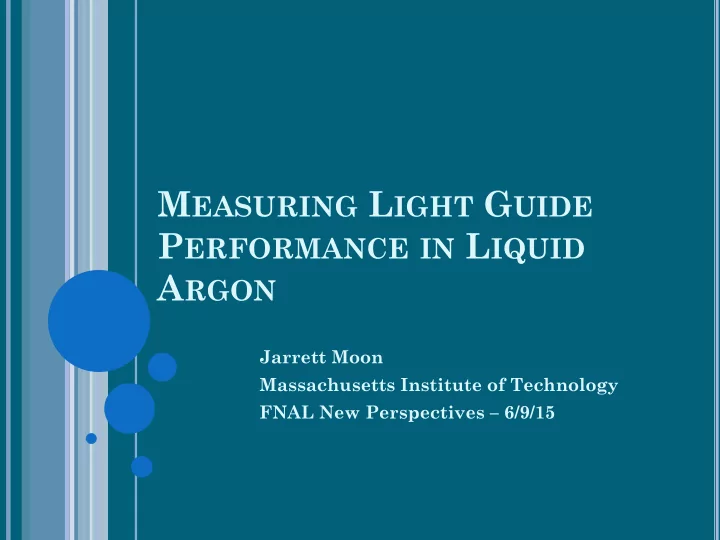

M EASURING L IGHT G UIDE P ERFORMANCE IN L IQUID A RGON Jarrett Moon Massachusetts Institute of Technology FNAL New Perspectives – 6/9/15
O UTLINE • Liquid argon scintillation • Measuring attenuation • Attenuation results • Using air to predict argon behavior • Adding Xenon • Conclusions 1
L IQUID A RGON S CINTILLATION Scintillation light is produced in LAr via the following reaction * Ar 2 Ar 128 nm 2 Ionized Argon atoms can form metastable molecules which then decay producing 128 nm light There is a fast (7 ns) and slow (1.6 μ s) component 2
O UTLINE • Liquid argon scintillation • Measuring attenuation • Attenuation results • Using air to predict argon behavior • Adding Xenon • Conclusions 3
“T ALL B O ” D EWAR Measurements were done at the FNAL proton assembly building in a high purity dewar dubbed “Tall Bo” This setup allowed us to carefully measure and minimize contaminants 4
M EASURING THE A TTENUATION We want to measure light output as a function of flash distance Flashes generated via scintillation produced by 5 Po-210 sources spaced along the bar 5 adjacent SiPMs act as triggers A PMT reads out the light output Another PMT is used for cosmic Veto 5
S YSTEM C ALIBRATION A UV LED was used to calibrate the PMT The LED was pulsed at low voltage to primarily produce single photoelectron events Fitting to this PMT data allows us to extract the calibration constants The SiPMs are easy to calibrate by eye 6
O UTLINE • Liquid argon scintillation • Measuring attenuation • Attenuation results • Using air to predict argon behavior • Adding Xenon • Conclusions 7
A TTENUATION R ESULTS We observed an attenuation length of ~50 cm which is a significant improvement over previous light guides 8
O UTLINE • Liquid argon scintillation • Measuring attenuation • Attenuation results • Using air to predict argon behavior • Adding Xenon • Conclusions 9
C ONNECTING A IR AND A RGON R ESULTS Testing these bars in liquid argon is time consuming, expensive, and relatively problem prone Can we create a model which links performance in air to the performance in argon? 10
C ONNECTING A IR AND A RGON R ESULTS Try a 3 parameter model Internal reflection which depends on the refractive index of the medium (air vs argon) Photon loss per reflection Coating thickness gradient Simultaneously fit the air data from a bar’s forward and backward runs to extract parameters Use light loss per bounce to deduce an attenuation curve for liquid argon 11
M ODEL R ESULTS The model correctly “post -dicts ” the argon attenuation curve we already measured 12
O UTLINE • Liquid argon scintillation • Measuring attenuation • Attenuation results • Using air to predict argon behavior • Adding Xenon • Conclusions 13
A DDING X ENON One promising avenue for improvement we plan to pursue this summer is doping the argon with ppm Xenon Xenon has several key benefits Its presence shifts the Argon late light to earlier times It reemits the Argon light at a higher wavelength, which will improve the efficiency of our wavelength shifting coat 14
O UTLINE • Liquid argon scintillation • Measuring attenuation • Attenuation results • Using air to predict argon behavior • Adding Xenon • Conclusions 15
C ONCLUSIONS Our measurements in air and liquid argon are both great improvements over prior light guides We can now reliably and consistently produce meter scale guides R&D is ongoing. We hope to push the attenuation of our guides higher, possibly to several meters 16
T HANK Y OU ! Q UESTIONS ? 17
Recommend
More recommend